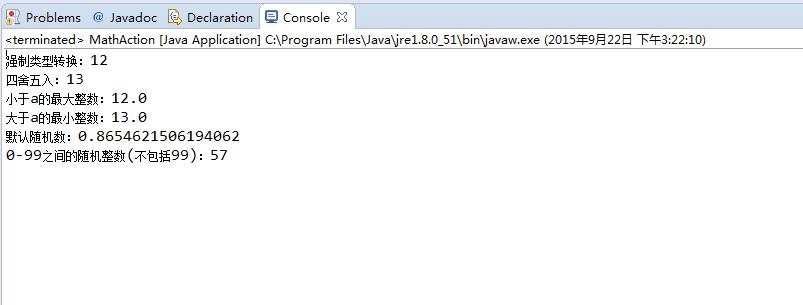1、Java的包装类
基本数据类型我们都很熟悉,例如:int、float、double、boolean、char等,基本数据类型不具备对象的特征,不能调用方法,一般能实现的功能比较简单,为了让基本数据类型也具备对象的特性,Java为每个数据类型都提供了一个包装类,这样我们就可以像操作对象一样,操作这些基本数据类型了
常见的包装类和基本类型对应关系如下:

包装类主要提供了两类方法:
1、进行多个类型之间的转换
2、将字符串和本类型及包装类相互转换
比如下面代码:
int i = 2; Integer m = new Integer(5); Integer n = new Integer("8");
第一行是用基本类型定义了整型变量i,第二行是利用int包装类定义了int对象m,虽然赋值为整型的5,但是现在会将基本类型转换为包装类中的5
第三行初始化值为字符串类型的"8",但是会被包装类转换成整数类型,这就是包装类的基本使用方法
每个包装类都可以和其他类进行转换,比如Integer包装类,转换的对应关系如下:

根据转换的对应关系,可以写一个简单的实例如下:
public class HelloWorld { public static void main(String[] args) { int score1 = 86; // 创建Integer包装类对象,表示变量score1的值 Integer score2=new Integer(score1); // 将Integer包装类转换为double类型 double score3=score2.doubleValue(); // 将Integer包装类转换为float类型 float score4=score2.floatValue(); // 将Integer包装类转换为int类型 int score5 =score2.intValue(); System.out.println("Integer包装类:" + score2); System.out.println("double类型:" + score3); System.out.println("float类型:" + score4); System.out.println("int类型:" + score5); } }
通过这个简单的包装类转换程序,可以看出包装类转换为各种基本数据类型也是很方便的
那么基本类型怎么转换为包装类的对象呢?其实前面三行代码已经体现了,只不过不太完全,基本类型转换为包装类可以理解为一个装箱的过程,装箱有两种方式:手动装箱和自动装箱,那么同理包装类转换为基本类型叫做拆箱,同样分为:手动拆箱和自动拆箱,上面的例子就是一个手动拆箱的例子,
那么其中自动装箱和自动拆箱,都是编译器根据数据类型自动完成了转换,简单的代码如下:
public class HelloWorld { public static void main(String[] args) { double a = 91.5; // double类型手动装箱 Double b = new Double(a); // double类型自动装箱 Double c = a; System.out.println("装箱后的结果为:" + b + "和" + c); Double d = new Double(87.0); // Double包装类对象手动拆箱 double e = d.doubleValue(); //Double包装类对象自动拆箱 double f = d; System.out.println("拆箱后的结果为:" + e + "和" + f); } }
例子很简单,对每一个数据类型分别完成了自动和手动两个操作,所以b和c的值是一样的,e和f的值是一样的
除了基本数据类型的包装转换之外,基本类型和字符串之间也可以进行转换
比如一个基本类型:int a = 30;有3中方式转换为字符串对象:
1、使用包装类的toString方法,String str1 = Integer.toString(a);
2、使用String类的valueOf方法,String str2 = String.valueOf(a);
3、用一个空字符串加上基本类型,系统会将基本类型转换为字符串类型,String str3 = a + "";
反过来,定义:String str = "18";将一个字符串类型转换为基本类型有以下两种方法:
1、调用包装类的parseXxx静态方法,int b = Integer.parseInt(str);
2、调用包装类的valueOf方法,完成自动拆箱,int c = Integer.valueOf(str);
其他类型转换也是一样,替换里面的类型即可,下面是一个简单的例子:
public class HelloWorld { public static void main(String[] args) { double m = 78.5; //将基本类型转换为字符串 String str1 = Double.toString(m); System.out.println("m 转换为String型后与整数20的求和结果为: "+(str1+20)); String str = "180.20"; // 将字符串转换为基本类型 Double a = Double.valueOf(str); System.out.println("str 转换为double型后与整数20的求和结果为: "+(a+20)); } }
这个例子实现了两次转换,所以str1+20应该输出:78.520,a+20应该输出:200.20,前者结果是字符串类型,后者结果是基本的浮点数类型
2、Java日期时间处理
程序开发中,时间处理必不可少,这些内容相对简单一些,会使用一些固定的类即可
首先,我们可以使用java.util包中的Date类来获取时间,方法如下:
Date d = new Date(); System.out.println(d);
这样是最简单的方法了,但是输出格式可能不太适合我们:Mon Sep 21 21:46:13 CST 2015
所以我们需要进行简单的修饰,那么这时需要java.text包中的SimpleDateFormat类中的format方法对文本进行格式化,代码如下:
Date d = new Date(); SimpleDateFormat sdf = new SimpleDateFormat("yyyy-MM-dd HH:mm:ss"); String today = sdf.format(d); System.out.println(today);
这样就输出了我们常用的时间:2015-09-21 21:51:39,另外格式我们也可以按照我们的需要定义
反过来呢,我们还可以把文本变成默认的时间格式,这用到了SimpleDateFormat类中的parse方法,但是这个方法可能会出现异常,所以需要java.text中的异常类ParseException类进行异常处理,看一个小实例:
import java.text.ParseException; import java.text.SimpleDateFormat; import java.util.Date; public class HelloWorld { public static void main(String[] args) throws ParseException { // 使用format()方法将日期转换为指定格式的文本 SimpleDateFormat sdf1 = new SimpleDateFormat("yyyy年MM月dd日 HH时mm分ss秒"); SimpleDateFormat sdf2 = new SimpleDateFormat("yyyy/MM/dd HH:mm"); SimpleDateFormat sdf3 = new SimpleDateFormat("yyyy-MM-dd HH:mm:ss"); // 创建Date对象,表示当前时间 Date now = new Date(); // 调用format()方法,将日期转换为字符串并输出 System.out.println(sdf1.format(now)); System.out.println(sdf2.format(now)); System.out.println(sdf3.format(now)); // 使用parse()方法将文本转换为日期 String d = "2015-9-21 21:56:36"; SimpleDateFormat sdf = new SimpleDateFormat("yyyy-MM-dd HH:mm:ss"); // 调用parse()方法,将字符串转换为日期 Date date = sdf.parse(d); System.out.println(date); } }
例子很简单,实现了时间格式化,文本到日期的转换
另外在java.util包中还有一个时间处理的Calendar类,因为Date类中的本身的设计方法,遭到了众多批评,所以推荐使用Calendar类来处理时间,Calendar类是一个抽象类,可以通过调用getInstance静态方法获得Calendar的一个对象,此对象默认由当前时间进行初始化,直接来一个简单的实例:
package com.imooc.collection; import java.util.Calendar; public class DateAction { public static void main(String[] args) { Calendar c = Calendar.getInstance(); //实例化Calendar对象 int year = c.get(Calendar.YEAR); //通过get方法获得当前年 int month = c.get(Calendar.MONTH) + 1; //月份0-11,需要加1 int day = c.get(Calendar.DAY_OF_MONTH); //日期 int hour = c.get(Calendar.HOUR_OF_DAY); //获取小时 int minute = c.get(Calendar.MINUTE); //获取分钟 int second = c.get(Calendar.SECOND); //获取秒数 System.out.println("当前时间:" + year + "年" + month + "月" + day + "日" + " " + hour + ":" + minute + ":" + second); } }
这样就打印出结果了:当前时间:2015年9月21日 22:12:13
Calendar还提供了getTime方法,用来获取Date对象,实现Calendar和Date对象的互转,还可以用getTimeInMillis获得1970年01月01日0时0分0秒,到当前时间的毫秒数,大约是Unix时间戳的1000倍
简单代码如下:
Date date = c.getTime(); //对象转换 Long time = c.getTimeInMillis(); //获取至现在的毫秒数 System.out.println("当前时间:" + date); System.out.println("当前毫秒数:" + time);
这样就实现了转换
3、Java数学运算Math类
Math类也是Java中做运算常用的类,在java.lang包中,这个系统会自动导入,这里简单的记录一下,常用的方法:

直接看一个简单的实例:
public class MathAction { public static void main(String[] args) { double a = 12.86; int b = (int) a; //强制类型转换 System.out.println("强制类型转换:" + b); long c = Math.round(a); //四舍五入 System.out.println("四舍五入:" + c); double d = Math.floor(a); //返回小于参数a的最大整数 System.out.println("小于a的最大整数:" + d); double e = Math.ceil(a); //返回大于参数a的最小整数 System.out.println("大于a的最小整数:" + e); double x = Math.random(); //产生[0,1)区间内的随机浮点数 System.out.println("默认随机数:" + x); int y = (int) (Math.random()*99); //产生[0,99)区间内的随机整数 System.out.println("0-99之间的随机整数(不包括99):" + y); } }
很容易理解的例子,效果如下:

以上就是Java开发中经常用到的类和方法,以上主要就是包装类、时间处理、数学计算这些